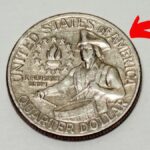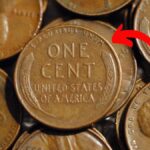The Lincoln Wheat Penny, a seemingly ordinary coin, has captured the attention of collectors and investors alike due to its rare value. A specific version of this penny, known for its historical significance and unique characteristics, has recently been valued at an astounding $3.1 million. While most of these pennies are still in circulation and remain worth just one cent, a select few have become extremely valuable due to their rarity, condition, and specific minting errors. This article will explore the history, rarity, and significance of the Lincoln Wheat Penny, and how one particular coin has achieved such an extraordinary value.
The History of the Lincoln Wheat Penny
The Lincoln Wheat Penny was first introduced in 1909 by the United States Mint. It was designed by Victor David Brenner, featuring a portrait of President Abraham Lincoln on the obverse (front) and two wheat stalks on the reverse (back). The coin was minted from 1909 to 1958 and became a staple of American currency during that time. The design was initially created to commemorate Lincoln’s 100th birthday, and the wheat motif was chosen to symbolize America’s agricultural heritage.
The Lincoln Wheat Penny was replaced in 1959 by the Lincoln Memorial Penny, which featured the Lincoln Memorial on the reverse instead of the wheat stalks. Despite being replaced by a new design, the Wheat Penny continued to be collected and studied by numismatists (coin collectors and experts) due to its historical importance.
Why Is One Lincoln Wheat Penny Worth $3.1 Million?
While the majority of Lincoln Wheat Pennies are worth just one cent, a few rare specimens have been valued at much higher amounts due to their rarity and unique features. The coin valued at $3.1 million is an example of a rare error coin that has captured the attention of collectors worldwide.
The specific penny in question is a 1943 copper-alloy version of the Lincoln Wheat Penny, which was accidentally struck during a time when most pennies were made of steel. In 1943, the U.S. Mint switched from using copper to zinc-coated steel for penny production due to copper shortages caused by World War II. However, a few copper-alloy planchets (blanks) were mistakenly used to strike some 1943 pennies. These copper pennies are incredibly rare, and the 1943 copper Lincoln Wheat Penny in particular is considered one of the most valuable coins in the world.
The Rarity of the 1943 Copper Penny
Only a few 1943 copper Lincoln Wheat Pennies are known to exist, and the rarity of these coins is what drives their astronomical value. Experts believe that only around 20 of these copper pennies were accidentally minted, and fewer than 10 are known to be in circulation today. This makes the 1943 copper Lincoln Wheat Penny one of the rarest coins in existence.
The coin that was valued at $3.1 million was sold at auction in 2010, setting a world record for the highest price ever paid for a Lincoln Wheat Penny. The buyer of the coin was a private collector, and the transaction underscored the growing interest in rare and unique coins, particularly those with historical significance.
Why Are Rare Coins Like the 1943 Copper Penny So Valuable?
Rare coins, such as the 1943 copper Lincoln Wheat Penny, become valuable for several reasons. First and foremost, rarity plays a significant role. Coins that were minted in small quantities or had unique characteristics are often in high demand among collectors. Additionally, coins that are in exceptional condition, free from wear and tear, are worth more than those in poor condition.
Errors during the minting process, such as the accidental use of copper planchets for the 1943 pennies, further increase a coin’s value. Collectors and investors seek out coins with minting errors because they are considered unique and historically significant.
The Lincoln Wheat Penny in Modern Circulation
Despite the extraordinary value of certain rare Lincoln Wheat Pennies, most of these coins are still in circulation today and remain worth just one cent. In fact, the majority of people who come across a Lincoln Wheat Penny in their change might not realize the potential value of a specific coin. However, it’s important to note that finding a 1943 copper penny or any other rare Lincoln Wheat Penny in everyday circulation is highly unlikely. Most of these coins are kept in private collections or are stored in numismatic vaults.
Conclusion: The Legacy of the Lincoln Wheat Penny
The Lincoln Wheat Penny, particularly the rare 1943 copper version, is a fascinating example of how a seemingly ordinary coin can become a highly sought-after collector’s item. With its rich history, unique design, and rare minting errors, the Lincoln Wheat Penny continues to capture the imagination of collectors and investors. While most of these coins are still circulating as one-cent pieces, the value of rare examples, such as the 1943 copper penny, demonstrates the lasting appeal of numismatics and the potential for unexpected treasures hidden in our everyday change.
Disclaimer: The information provided in this article is for informational purposes only. The value of coins can fluctuate, and readers should consult a professional numismatist for accurate assessments.




